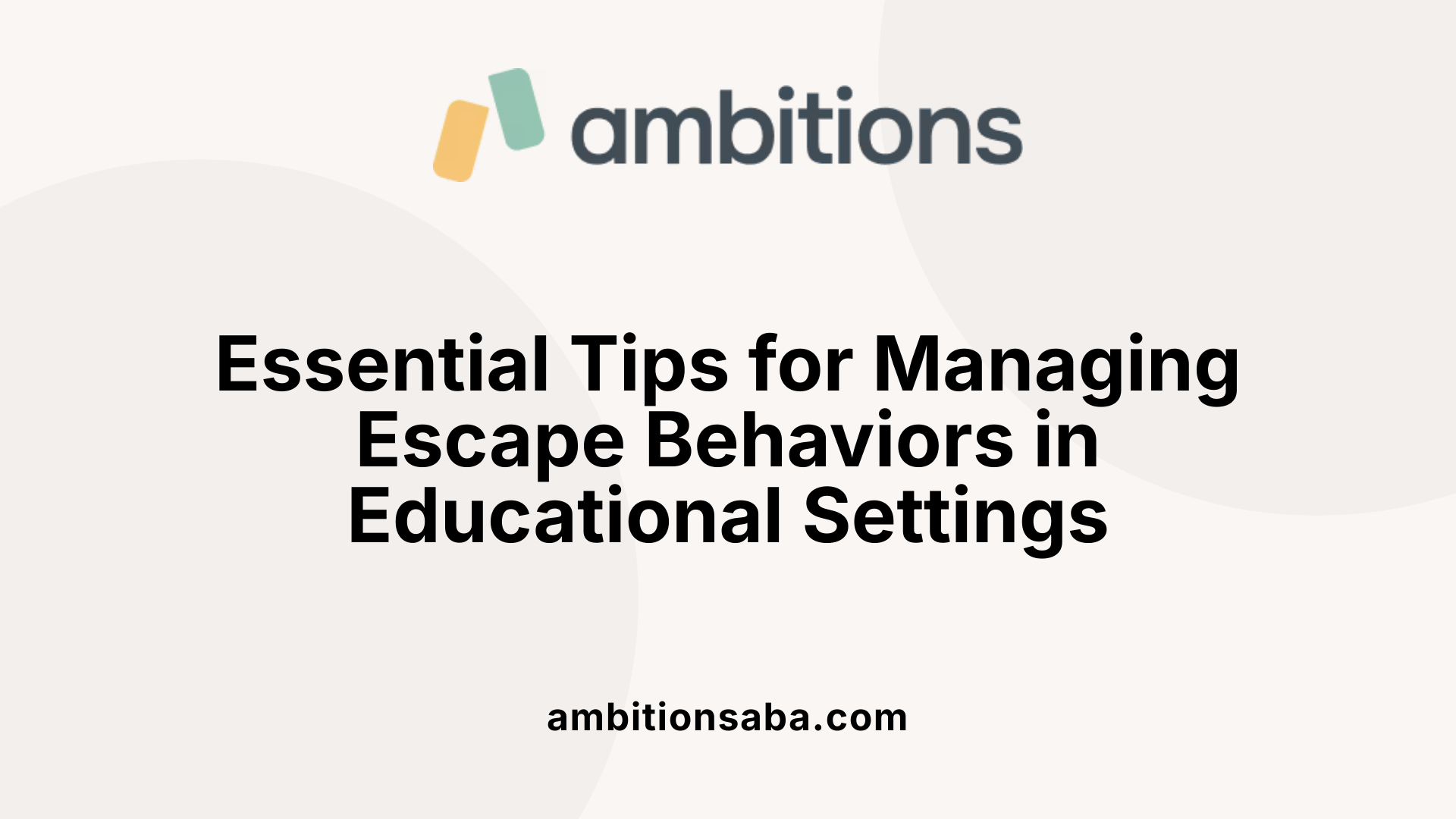Understanding and Addressing Escape Behaviors: A Guide for Educators and Practitioners
Escape behaviors are common among children and students with autism, serving as a way to avoid or delay unpleasant tasks or social situations. Recognizing these behaviors and understanding their functions are crucial steps toward developing effective replacement strategies. This article explores how to identify escape-maintained behaviors, implement tailored interventions, and teach functional alternatives that foster positive outcomes in both educational and therapeutic contexts.
Identifying Escape Behaviors: Observation and Functional Assessment

What are common examples of escape-maintained behaviors?
Escape-maintained behaviors are actions performed by individuals to avoid or terminate situations they find aversive. In children with autism, these behaviors often serve as a way to escape from demanding tasks or social interactions.
Common examples include throwing materials, acting out, tantrums, or verbal aggression when faced with challenging assignments like math worksheets or reading tasks. Children may also engage in self-injurious behaviors during therapy to escape the therapeutic setting or specific interventions.
These behaviors are primarily intended to avoid or delay unpleasant stimuli or activities, providing temporary relief for the individual. Recognizing these behaviors is the first step toward effective intervention.
How can escape behaviors be identified and replaced?
Identification begins with conducting a thorough functional behavior assessment (FBA). This process involves observing the child's behavior across different settings, collecting detailed data, and analyzing the circumstances that trigger escape behaviors.
Once the function—such as avoiding work, social interactions, or sensory overload—is clarified, appropriate replacement behaviors can be taught. This often involves functional communication training (FCT), which helps the child learn to request a break or assistance using visual supports, social stories, or prompts.
Consistent reinforcement of these communication strategies encourages their use while extinction of escape behaviors reduces their occurrence. For example, teaching a child to use a break card or to verbally ask for a pause provides an acceptable alternative to escape actions.
Combining careful assessment with behavior skill training creates a supportive framework that fosters more appropriate responses, decreasing avoidance behaviors and increasing functional independence.
Understanding the Functions of Escape Behaviors and Their Impact

The motivation behind escape behaviors
Escape behaviors are actions that individuals perform to avoid or escape from challenging or unpleasant situations. For children with autism, these behaviors often serve as a mechanism to avoid difficult tasks, social interactions, or overwhelming sensory environments. For example, a child might throw materials during a math lesson or become verbally aggressive when asked to complete a reading task. These actions are driven by the desire to stop or delay the aversive stimulus they are experiencing.
How escape behaviors serve the individual’s needs
These behaviors are the individual’s way of satisfying a need for relief from discomfort or demand. When faced with an overwhelming assignment or social situation, escape behaviors temporarily remove the source of stress, providing immediate relief. This can reinforce the behavior, making it more likely to recur whenever similar challenges arise. For example, a child may tantrum or escape the setting to avoid discomfort or frustration, which inadvertently maintains the behavior.
The importance of function-based interventions
Interventions that are based on understanding the function behind escape behaviors are crucial for effective behavior management. Functional Behavior Assessment (FBA) helps identify whether the behavior is maintained by escape, attention, tangible, or automatic reinforcement. Once the function is understood, tailored strategies such as teaching alternative communication methods—like requesting a break—can be implemented. Replacing escape behaviors with appropriate responses, such as asking for a break with a visual card or verbal prompt, reduces problematic actions and encourages adaptive communication.
Here's an overview of common escape-maintained behaviors and their replacements:
| Escape Behavior | Replacement Behavior | Function | Notes |
|---|---|---|---|
| Throwing materials | Requesting a break | Avoidance | Reinforced by giving a break |
| Verbal outbursts | Asking for help | Escape | Use visual supports or prompts |
| Leaving the activity | Using a signal for break | Escape | Consistent reinforcement for request |
| Physical removal from setting | Using a break card | Avoids demand | Fading prompts gradually |
Incorporating these understanding insights into intervention planning supports positive behavioral changes and promotes emotional well-being for children with autism.
Techniques and Strategies for Managing Escape Behaviors
What strategies and interventions can be used to manage escape behaviors?
Managing escape behaviors effectively involves understanding their function and applying tailored strategies to address the underlying needs. One fundamental approach is providing scheduled and contingent breaks, which help prevent frustration and reduce the likelihood of escape behaviors. These breaks should be taught as part of functional communication training (FCT), enabling children to request a break in appropriate ways like using picture cards, social stories, or verbal prompts.
Modifying the task environment is another crucial element. Tasks can be broken down into smaller, manageable steps, and demand fading techniques can be used to gradually increase difficulty while ensuring success. Shortening tasks or offering choices about the order of activities can make demands more acceptable, encouraging participation without resorting to escape behaviors.
Visual supports such as schedules, charts, or tokens help children understand what to expect and track their progress, reducing anxiety and frustration that often lead to escape. When combined with environmental adjustments—like creating a less overwhelming sensory environment or providing preferred items—they can significantly diminish escape-seeking actions.
Reinforcement strategies also play a vital role. Noncontingent reinforcement (NCR), where access to preferred activities or items is provided on a timed schedule, can decrease the motivation to escape by fulfilling some of the child’s needs proactively.
Overall, an integrated approach that combines task modifications, visual supports, reinforcement strategies, and environmental adjustments presents the most effective way to manage escape behaviors. The goal is to teach functional communication skills, reduce the need for escape, and promote independence and positive engagement.
Implementing Behavior Replacement Techniques: Practical Steps

Teaching appropriate replacement behaviors
To effectively manage escape behaviors, it’s vital to teach students alternatives that serve the same function. For example, instead of escaping a difficult task, students can be taught to request a break or help verbally, with picture cards, or through social stories. These replacement behaviors should be simple, observable, measurable, and consistently reinforced. The goal is to encourage communication skills that offer socially valid ways of meeting needs.
Dividing tasks into manageable steps
Breaking down complex or overwhelming tasks into smaller, manageable parts can help reduce frustration and the urge to escape. For instance, if a student struggles with a worksheet, splitting it into sections or individual questions allows for easier completion. Teaching the student to request a break after each step or small segment can reinforce appropriate escape requests and decrease problematic behaviors.
Using visual aids and prompts
Visual support tools such as schedules, break cards, or social stories can significantly aid in teaching replacement behaviors. Visual schedules help students anticipate when they will receive reinforcement or a break, reducing anxiety and escape behaviors. Prompts, whether verbal, gestural, or visual, guide students to use the appropriate requests, and these prompts can be gradually faded as the skill becomes stable.
Reinforcing and fading skills over time
Immediate and consistent reinforcement of appropriate behaviors is essential in establishing new skills. Over time, reinforcement should be gradually faded to promote independence, using visual cues like counters or timers to indicate the number of remaining breaks or activities. This process ensures that the student maintains the skill without over-reliance on prompts or reinforcers, fostering generalization across different settings.
How can behavior replacement techniques be practically implemented?
Behavior replacement techniques can be practically implemented by first understanding the reason behind the escape behavior through a functional assessment. After establishing the function, such as escape or avoidance, a suitable alternative is taught. This might involve providing visual aids like break cards or social stories, dividing tasks into smaller parts, and offering choices to increase engagement. Consistent reinforcement of the new, appropriate behavior helps it become habitual. Using visual schedules and prompts supports the teaching process, and a gradual fading of prompts and reinforcement ensures the skills are maintained and generalized. This systematic approach aligns with applied behavior analysis (ABA) principles and promotes positive behavioral changes over time.
Components of an Effective Intervention Plan for Escape Behaviors
What components should be included in an intervention plan for escape-maintained behaviors?
An effective plan to address escape-maintained behaviors relies on a comprehensive understanding of why the behavior occurs. The foundation is a detailed Functional Behavior Assessment (FBA) that helps identify whether the child is trying to avoid a task, social situation, or sensory input. This assessment guides all subsequent strategies.
Once the function is established, teaching is centered on developing appropriate communication responses. These are alternative ways for a child to request a break, help, or a change of activity. Visual supports such as picture exchange communication systems, social stories, or visual schedules are often used to help children understand and verbalize their needs.
Environmental adjustments further support positive behavior. These include task modifications like shortening work periods, providing preferred activities as rewards, and embedding choices into activities to increase engagement. For example, allowing children to select which task to do first can reduce the desire to escape.
Consistent reinforcement is crucial. When children use appropriate communication or tolerate tasks without escape behaviors, they should be promptly rewarded with reinforcement like praise, access to preferred items, or additional breaks. Data collection should be ongoing to monitor progress and inform adjustments.
Other effective strategies involve applying extinction to problematic behaviors—ignoring escape behaviors while reinforcing alternative responses—and behavioral momentum by first having the child complete easy tasks to build confidence.
Team-wide consistency, including caregiver involvement and training, ensures that these strategies are implemented uniformly across various environments. Response prompts, peer modeling, and proactive strategies to de-escalate behaviors also contribute to a robust intervention plan.
Together, these components help create a supportive system that reduces escape behaviors and encourages healthier, functional communication skills, leading to improved learning outcomes and emotional well-being.
Key Considerations for Educators and Practitioners

What are the key considerations for educators and practitioners when addressing escape and avoidance behaviors?
When working to reduce escape and avoidance behaviors in children with autism, professionals must start with a thorough understanding of the behavior's function. Conducting functional behavior assessments (FBAs) helps identify triggers and underlying needs, guiding the development of targeted interventions.
A crucial step is teaching students alternative ways to communicate their needs, such as requesting a break or help. Functional Communication Training (FCT) is highly effective here, providing socially valid methods for students to express their desire to escape or avoid tasks.
Environmental modifications can significantly decrease escape behaviors. Visual schedules, timers, and sensory enrichment activities help create predictable and engaging environments, reducing frustration and the need to escape.
Interventions often include modifying tasks—shortening demands, offering choices, and providing preferred items or activities after task completion—to make learning more motivating and less aversive.
Consistent data collection and ongoing analysis of the student's responses are essential to evaluate intervention effectiveness. Techniques such as reinforcement of appropriate requesting, differential reinforcement of alternative behaviors (DRA), and non-contingent reinforcement (NCR) should be adjusted based on this data.
Safety and respect for the student's autonomy are paramount. Interventions should promote a supportive atmosphere that respects individual needs and encourages independence while ensuring safety during challenging behaviors.
By integrating these strategies—behavior analysis, environmental supports, consistent monitoring, and respect for the student—educators and practitioners can more effectively manage escape behaviors and support positive development.
Integrating Assessment and Intervention for Lasting Change
Effective management of escape behaviors hinges on thorough assessment, individualized intervention planning, and ongoing data analysis. By understanding the underlying functions, teaching appropriate replacement behaviors, and creating supportive environments, educators and practitioners can significantly reduce problematic escape responses. Emphasizing functional communication, environmental adjustments, and consistent reinforcement ensures that children develop more adaptive ways to meet their needs, ultimately fostering greater independence, engagement, and emotional well-being.
References
- Escape Behaviors {Replacement Behaviors} - The Autism Helper
- Teaching Replacement Behaviors for Escape Behaviors
- [PDF] Selecting Effective Replacement Behaviors
- Replacement Behaviors
- Understanding and Managing Escape Behaviors in ABA Therapy
- Page 3: Replacement Behaviors - IRIS Center
- ABA Behind the Scenes: Replacement Behavior - Verbal Beginnings
- Replacement Skills for Challenging Behavior: FCT & Flexibility
- 3 Interventions to Decrease Escape Behaviors - Simply Special Ed
- What are Escape Behaviors?



